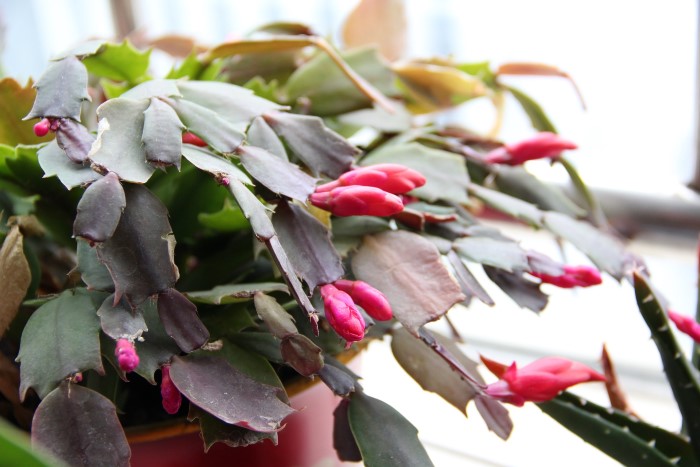Christmas cactus, often regarded as a seasonal gem, captivates the hearts of many during the festive season. With its vibrant foliage and striking blooms, it beckons the question: how often does a Christmas cactus bloom? This inquiry is not only rooted in routine curiosity but also uncovers the intricate nuances of plant behavior and care.
The blooming frequency of a Christmas cactus primarily hinges on its environmental conditions and maintenance regimen. Generally, one can expect a healthy Christmas cactus to bloom once a year, typically in late fall or early winter, coinciding with the holiday season. The ethereal blossoms unfurl in a breathtaking array of colors, ranging from fuchsia to white and even apricot, contributing to the plant’s seasonal charm.
Unlike other succulents that may exhibit sporadic flowering patterns, the Christmas cactus adheres to a more predictable timetable. Such regularity is one of the reasons that enthusiasts find this plant especially enchanting. Its blooms are a celebration of nature’s cycles, showcasing the delicate interplay between light, temperature, and moisture that governs floral production.
There is an inherent fascination in observing these cycles; the periodicity of their bloom mirrors the cyclical nature of life itself. This brings us to a deeper understanding of what influences the blooming of a Christmas cactus.
Environmental Triggers for Blooms
The blooming of a Christmas cactus is acutely sensitive to changes in environmental conditions. Light, temperature, and humidity play critical roles in signaling to the plant when it is time to produce flowers. This pivotal transformation typically occurs when days grow shorter and temperatures dip—a phenomenon known as photoperiodism.
During the late summer and early fall, it is crucial to manipulate lighting for optimal blooming stimulation. Reducing light exposure to about 12-14 hours a day, coupled with a drop in nighttime temperature to around 50-55°F (10-13°C), will effectively encourage the plant to enter a dormancy phase conducive to future flowering.
Additionally, the Christmas cactus thrives in a humid environment. Inadequate humidity can lead to stress, which may inhibit blossoming. Regular misting or placing the plant on a pebble tray filled with water can help maintain the moisture levels it craves. The delicate balance of light and moisture forms the foundation upon which your Christmas cactus will flourish, ensuring it is primed for its annual display of colorful blooms.
Nurturing the Blooming Process
Proper care and nutrition play significant roles in determining the frequency and quality of blooms. Fertilization is particularly important during the growing season, which typically occurs in the spring and summer months. During this time, use a balanced, water-soluble fertilizer to bolster growth. A well-nourished plant is more likely to reward you with bountiful blossoms come wintertime.
Watering practices are equally essential. Unlike its desert-dwelling relatives, the Christmas cactus prefers a moderate watering approach. Over-watering can lead to root rot, while under-watering may cause dehydration, both of which inhibit flowering potential. A well-draining potting mix is crucial to ensure adequate moisture retention without sogginess, allowing for thriving root development.
The plant will exhibit subtle signs of dormancy as it prepares for its winter spectacular. Yellowing leaves may signify overwatering, while shriveling could indicate dryness. Understanding these cues is vital for maintaining optimal health and subsequent blooming.
A Curated Environment for Lasting Blooms
Creating an ideal environment is not merely about replicating natural conditions; it involves an understanding of the Christmas cactus’s innate preferences. Following its natural habitat, which is typically found in the cloud forests of Brazil, involves ensuring ample airflow while protecting it from harsh, direct sunlight. Bright, indirect light fosters healthy growth without scorching the leaves.
Temperature fluctuations should be minimized in the weeks leading up to blooming. Sudden changes can stress the plant; thus, maintaining a stable environment will promote consistency in flowering. Also, consider the pot size; a cramped space can hinder growth, while a pot that is too large can lead to overwatering issues. Ideally, a pot that allows for small progressions in growth without overwhelming the root system will yield optimal results.
Embracing the Waiting Game
The anticipation of blooms often brings with it a profound appreciation for the Christmas cactus. Its blooming cycle reminds us of the patience that nature necessitates. While one can ensure the appropriateness of environmental variables, the plant’s internal clock remains unpredictable. This adds an element of intrigue that is absent in many other household plants.
Moreover, the captivating blossoms of the Christmas cactus are a temporary gift. Enhancing the visual spectacle requires a commitment to care and understanding, allowing one to appreciate the broader tapestry of botanical life. The investment in nurturing this plant extends beyond mere aesthetics; it entwines with lessons of patience, observation, and the intricacies of nurturing life itself.
Ultimately, the Christmas cactus, with its rich lineage and complex needs, presents a rewarding experience for plant enthusiasts and novices alike. It blooms once a year, but the joy it brings during the holiday season lingers long after the last flower has fallen. Each bloom is an affirmation of the care and attention imbued in the lifecycle of a captivating plant that reflects the cyclic rhythms of nature.





Leave a Comment